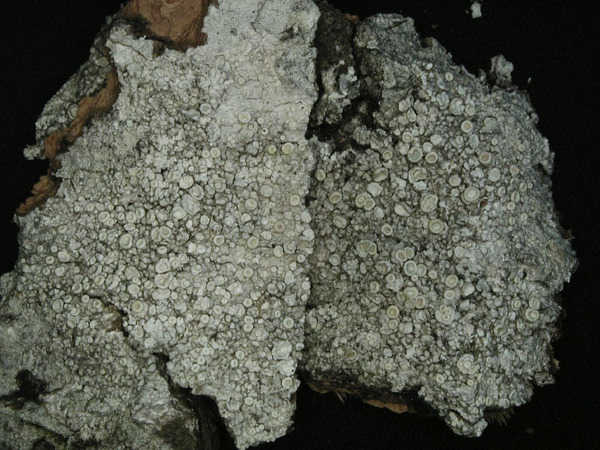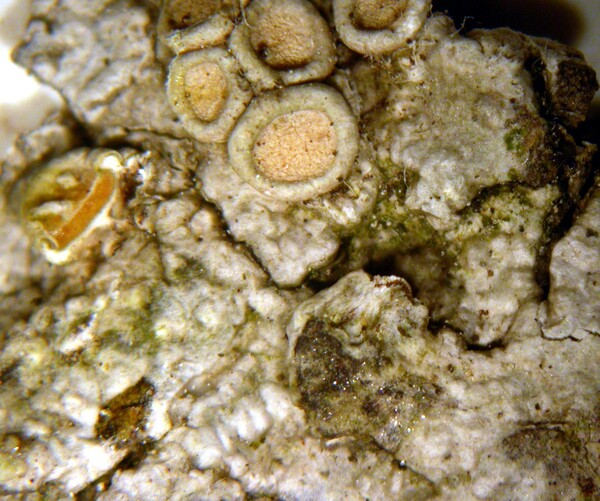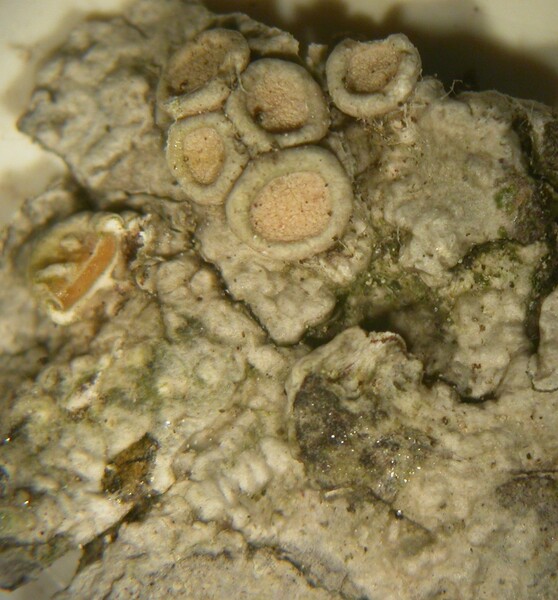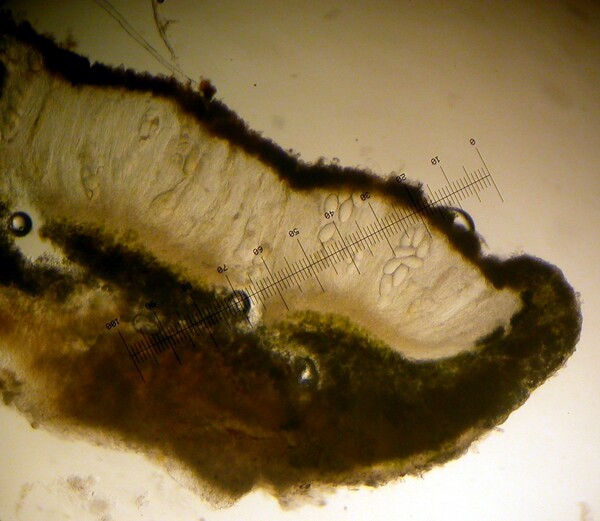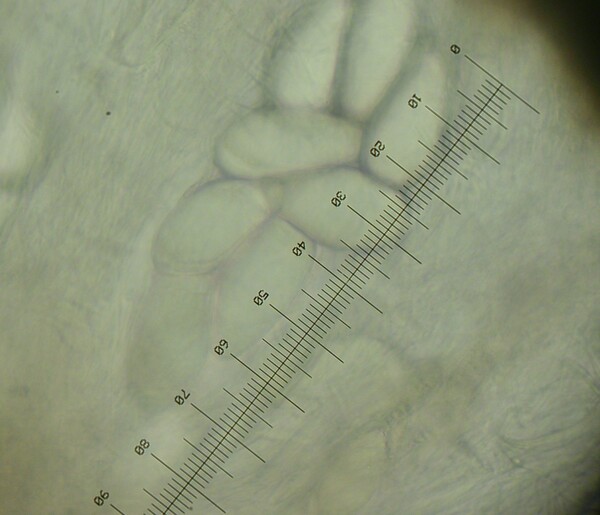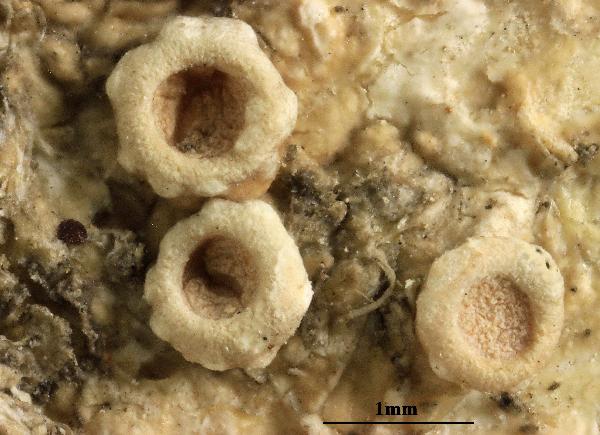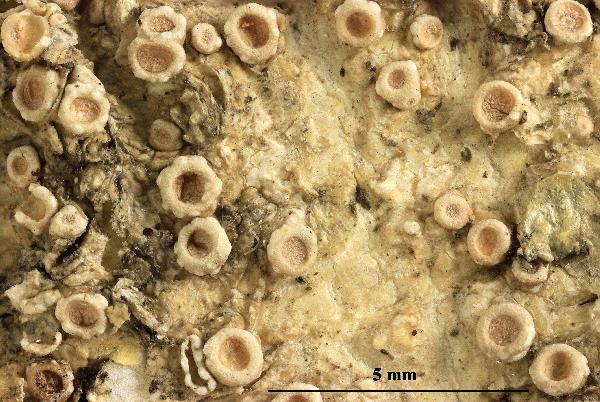Ochrolechia poriniza (Nyl.) ined.
. Basionym: Pertusaria poriniza Nyl. - Flora, 57, 1:8-9, 1874.
Synonyms: Ochrolechia pseudotartarea (Vain.) Verseghy; Ochrolechia szatalaensis var. macrospora Verseghy; Ochrolechia szatalaensis Verseghy; Ochrolechia tenuissima Verseghy
Distribution: N - Frl, Ven (Nascimbene & Caniglia 2000, 2003c, Nascimbene & al. 2006e, Nascimbene 2008c, Kukwa 2011), TAA (Nascimbene 2006b, 2008b, 2014, Nascimbene & al. 2006e, 2007b, 2014, 2022, Kukwa 2011, Nimis & al. 2015), Lomb, Lig (Giordani & al. 2025). C - Tosc (Benesperi & al. 2007, Kukwa 2011), Abr (Brackel 2015), Sar (Zedda 2002, Cossu 2013). S - Bas (S-F118647), Cal (Puntillo 1995, 1996), Si (Brackel 2008c).
Description: Thallus crustose, endosubstratic or episubstratic, continuous to rimose-areolate, yellowish grey, whitish grey or pale brown, usually without a distinct prothallus. Apothecia lecanorine, 1-2.5 mm across, sessile, rounded or irregular, with a slightly concave to flat, flesh-coloured but densely yellowish- or brownish-grey pruinose disc (the pruina granular) and a thick, entire or rarely flexuose, smooth or rough thalline margin. Thalline exciple cortiate, the cortex of the margin well developed, laterally thinner, white in section, up to 70 µm thick, expanded at the base to c. 170(-200) µm, glassy, but opaque (best visible in sectioned apothecia under the stereomicroscope); medulla rich in algal cells; excipular ring or discoid like tissue absent; proper exciple well-developed; epithecium brownish, C- (the pruina C+ yellow); hymenium colourless, (160-)220-300 μm high; paraphyses thin, slender, densely branched and anastomosing; hypothecium yellowish. Asci (4-)6-8-spored, with thick, amyloid walls, without recognizable apical structures, Pertusaria-like. Ascospores 1-celled, hyaline, ellipsoid but often deformed, rather variable in size, 30-80 x (15-)20-43 μm. Photobiont chlorococcoid. Spot tests: outer part of cortex K-, C+ yellow, P-; medulla C-, KC-; apothecial margins C+ yellow and partially (inner part only) C-, KC+ pink; pruina of the apothecial disc usually C+ yellow. Chemistry: thallus and pruina of the apothecia with variolaric acid (major), accompanied by different unknown substances; thalline margin of apothecia often with alectoronic acid and fatty acids of the murolic acid complex. Note: a cool-temperate to boreal-montane species with optimum on twigs in humid and cold sites; certainly widespread thoughout the Alps. The identification of the sample from Sicily by Brackel (2008c) is not fully certain. It is included in the Italian red list of epiphytic lichens under the “Least Concern” category (Nascimbene & al. 2013c). As the proposal to conserve the epithet szatalaensis against Pertusaria poriniza Nyl. was rejected, the correct name should be Ochrolechia poriniza.
Growth form: Crustose
Substrata: bark
Photobiont: green algae other than Trentepohlia
Reproductive strategy: mainly sexual
Commonnes-rarity: (info)
Alpine belt: absent
Subalpine belt: extremely rare
Oromediterranean belt: absent
Montane belt: very rare
Submediterranean belt: absent
Padanian area: absent
Humid submediterranean belt: absent
Humid mediterranean belt: absent
Dry mediterranean belt: absent
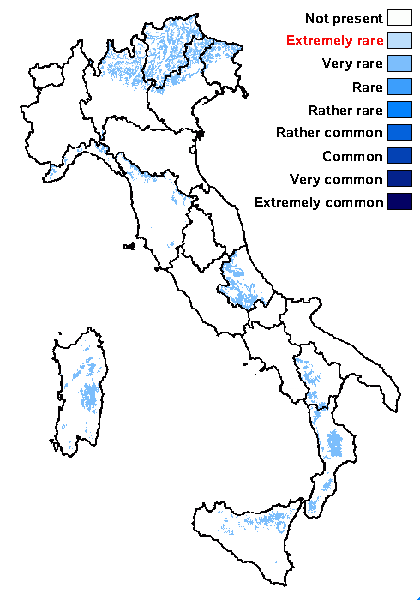
Predictive model
Herbarium samples
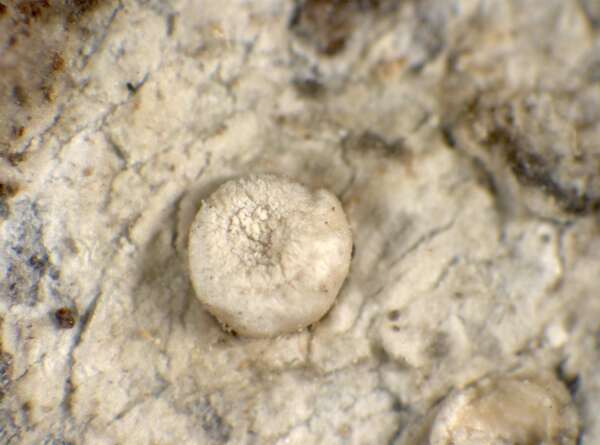

P.L. Nimis; Owner: Department of Life Sciences, University of Trieste
Herbarium: TSB (10645)
2001/12/10
apothecium


P.L. Nimis; Owner: Department of Life Sciences, University of Trieste
Herbarium: TSB (35713)
2003/01/22
apothecium
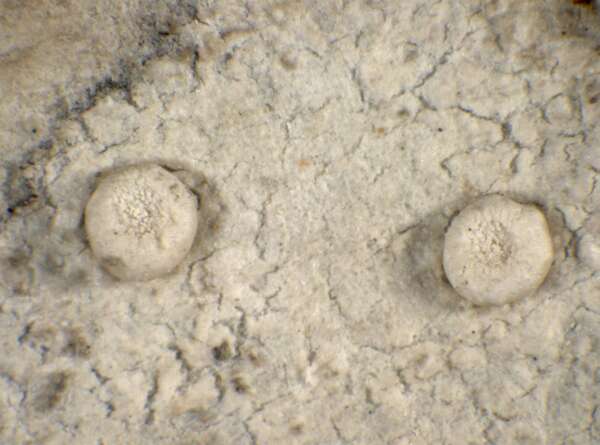

P.L. Nimis; Owner: Department of Life Sciences, University of Trieste
Herbarium: TSB (10645)
2001/12/10
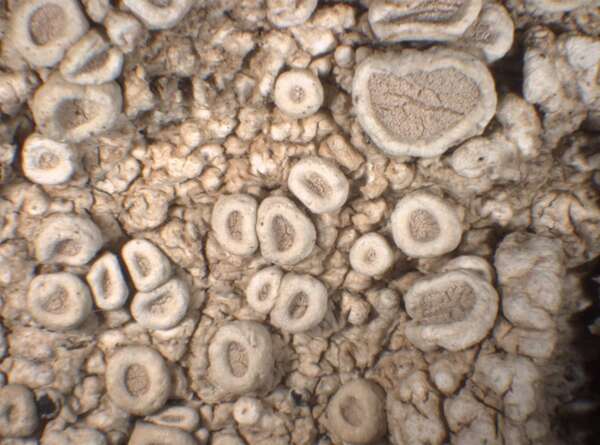

P.L. Nimis; Owner: Department of Life Sciences, University of Trieste
Herbarium: TSB (35713)
2003/01/22
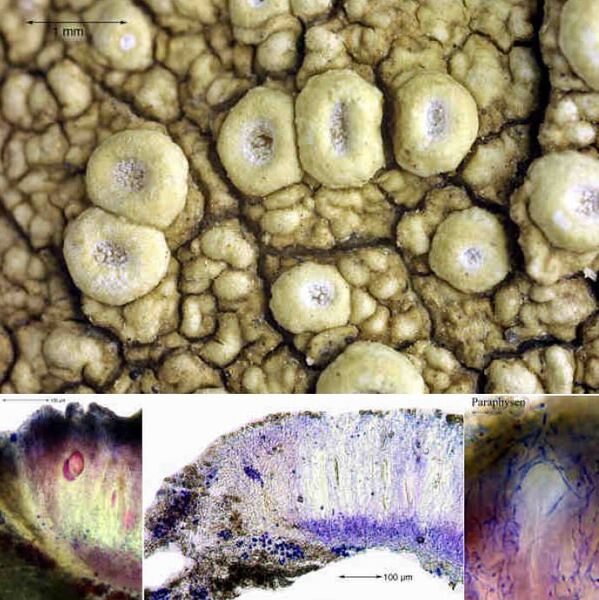

Felix Schumm – CC BY-SA 4.0
Image from: F. Schumm (2008) - Flechten Madeiras, der Kanaren und Azoren. Beck, OHG - ISBN: 978-3-00-023700-3
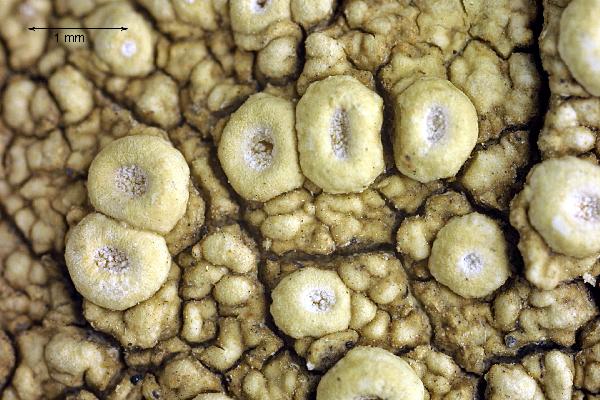

Felix Schumm - CC BY 4.0
[9385], Spanien, Kanaren, La Gomera: Bei Arure an der Straße nach
Las Hayas. Trockener Abhang mit Felsblöcken und Euphorbia.
28°07.895 N, 17°18.983 W, 870 m, an Rinde . Leg. F.
Schumm, 14.02.2002, det. F. Schumm, 2007. - Hymenium 270 μm,
Paraphysen stark verzweigt; Sporen meist verkümmert, breit ellipsoidisch,
50-60 x 27-33 μm. Thallus K-, C+ gelb, KC-, P-; Scheibe K-, C-,
KC- bis etwas gelblich, P-. As O. szatalaensis


Felix Schumm - CC BY 4.0
[9385], Spanien, Kanaren, La Gomera: Bei Arure an der Straße nach
Las Hayas. Trockener Abhang mit Felsblöcken und Euphorbia.
28°07.895 N, 17°18.983 W, 870 m, an Rinde . Leg. F.
Schumm, 14.02.2002, det. F. Schumm, 2007. - Hymenium 270 μm,
Paraphysen stark verzweigt; Sporen meist verkümmert, breit ellipsoidisch,
50-60 x 27-33 μm. Thallus K-, C+ gelb, KC-, P-; Scheibe K-, C-,
KC- bis etwas gelblich, P-. As O. szatalaensis


Felix Schumm - CC BY 4.0
[9385], Spanien, Kanaren, La Gomera: Bei Arure an der Straße nach
Las Hayas. Trockener Abhang mit Felsblöcken und Euphorbia.
28°07.895 N, 17°18.983 W, 870 m, an Rinde . Leg. F.
Schumm, 14.02.2002, det. F. Schumm, 2007. - Hymenium 270 μm,
Paraphysen stark verzweigt; Sporen meist verkümmert, breit ellipsoidisch,
50-60 x 27-33 μm. Thallus K-, C+ gelb, KC-, P-; Scheibe K-, C-,
KC- bis etwas gelblich, P-. As O. szatalaensis


Felix Schumm - CC BY 4.0
[9385], Spanien, Kanaren, La Gomera: Bei Arure an der Straße nach
Las Hayas. Trockener Abhang mit Felsblöcken und Euphorbia.
28°07.895 N, 17°18.983 W, 870 m, an Rinde . Leg. F.
Schumm, 14.02.2002, det. F. Schumm, 2007. - Hymenium 270 μm,
Paraphysen stark verzweigt; Sporen meist verkümmert, breit ellipsoidisch,
50-60 x 27-33 μm. Thallus K-, C+ gelb, KC-, P-; Scheibe K-, C-,
KC- bis etwas gelblich, P-. As O. szatalaensis
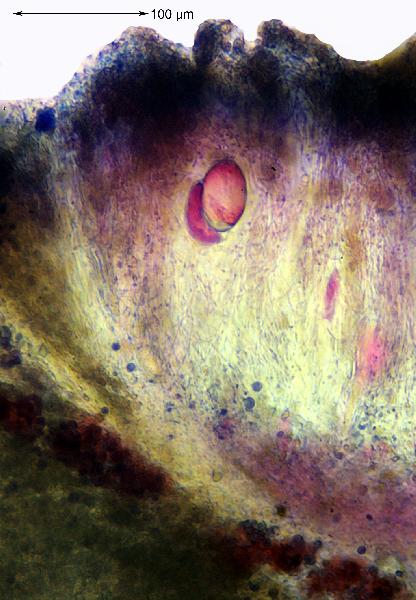

Felix Schumm - CC BY 4.0
[9385], Spanien, Kanaren, La Gomera: Bei Arure an der Straße nach
Las Hayas. Trockener Abhang mit Felsblöcken und Euphorbia.
28°07.895 N, 17°18.983 W, 870 m, an Rinde . Leg. F.
Schumm, 14.02.2002, det. F. Schumm, 2007. - Hymenium 270 μm,
Paraphysen stark verzweigt; Sporen meist verkümmert, breit ellipsoidisch,
50-60 x 27-33 μm. Thallus K-, C+ gelb, KC-, P-; Scheibe K-, C-,
KC- bis etwas gelblich, P-. As O. szatalaensis
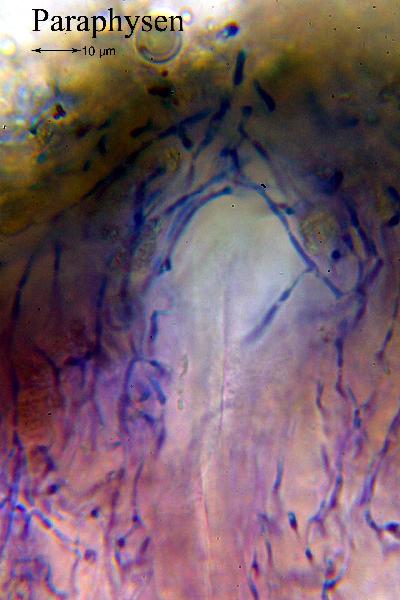

Felix Schumm - CC BY 4.0
[9385], Spanien, Kanaren, La Gomera: Bei Arure an der Straße nach
Las Hayas. Trockener Abhang mit Felsblöcken und Euphorbia.
28°07.895 N, 17°18.983 W, 870 m, an Rinde . Leg. F.
Schumm, 14.02.2002, det. F. Schumm, 2007. - Hymenium 270 μm,
Paraphysen stark verzweigt; Sporen meist verkümmert, breit ellipsoidisch,
50-60 x 27-33 μm. Thallus K-, C+ gelb, KC-, P-; Scheibe K-, C-,
KC- bis etwas gelblich, P-. As O. szatalaensis
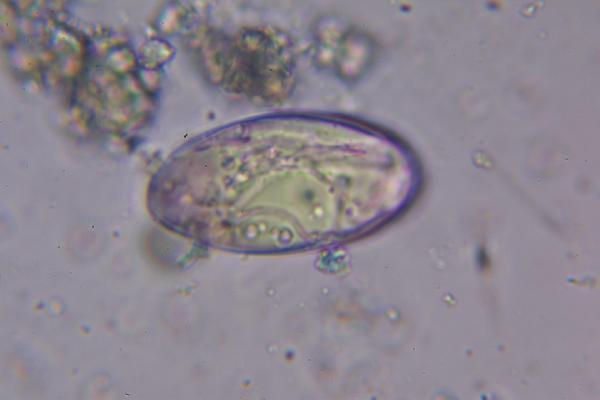

Felix Schumm - CC BY 4.0
[9385], Spanien, Kanaren, La Gomera: Bei Arure an der Straße nach
Las Hayas. Trockener Abhang mit Felsblöcken und Euphorbia.
28°07.895 N, 17°18.983 W, 870 m, an Rinde . Leg. F.
Schumm, 14.02.2002, det. F. Schumm, 2007. - Hymenium 270 μm,
Paraphysen stark verzweigt; Sporen meist verkümmert, breit ellipsoidisch,
50-60 x 27-33 μm. Thallus K-, C+ gelb, KC-, P-; Scheibe K-, C-,
KC- bis etwas gelblich, P-. As O. szatalaensis
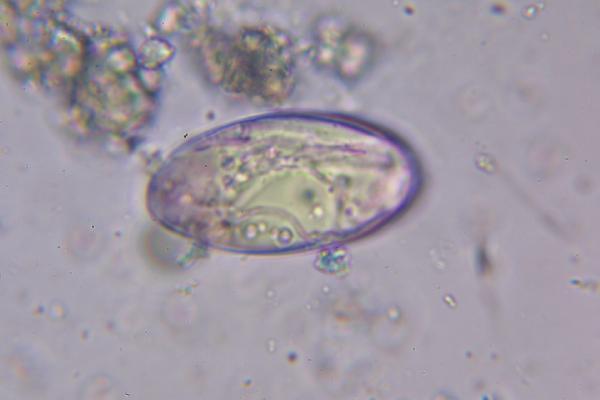

Felix Schumm - CC BY 4.0
[9385], Spanien, Kanaren, La Gomera: Bei Arure an der Straße nach
Las Hayas. Trockener Abhang mit Felsblöcken und Euphorbia.
28°07.895 N, 17°18.983 W, 870 m, an Rinde . Leg. F.
Schumm, 14.02.2002, det. F. Schumm, 2007. - Hymenium 270 μm,
Paraphysen stark verzweigt; Sporen meist verkümmert, breit ellipsoidisch,
50-60 x 27-33 μm. Thallus K-, C+ gelb, KC-, P-; Scheibe K-, C-,
KC- bis etwas gelblich, P-. As O. szatalaensis


Felix Schumm - CC BY 4.0
[9385], Spanien, Kanaren, La Gomera: Bei Arure an der Straße nach
Las Hayas. Trockener Abhang mit Felsblöcken und Euphorbia.
28°07.895 N, 17°18.983 W, 870 m, an Rinde . Leg. F.
Schumm, 14.02.2002, det. F. Schumm, 2007. - Hymenium 270 μm,
Paraphysen stark verzweigt; Sporen meist verkümmert, breit ellipsoidisch,
50-60 x 27-33 μm. Thallus K-, C+ gelb, KC-, P-; Scheibe K-, C-,
KC- bis etwas gelblich, P-. As O. szatalaensis
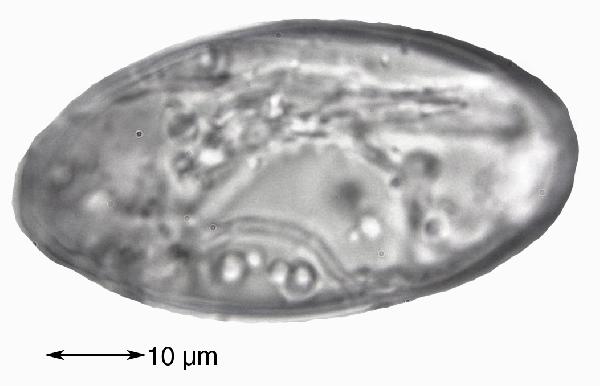

Felix Schumm - CC BY 4.0
[9385], Spanien, Kanaren, La Gomera: Bei Arure an der Straße nach
Las Hayas. Trockener Abhang mit Felsblöcken und Euphorbia.
28°07.895 N, 17°18.983 W, 870 m, an Rinde . Leg. F.
Schumm, 14.02.2002, det. F. Schumm, 2007. - Hymenium 270 μm,
Paraphysen stark verzweigt; Sporen meist verkümmert, breit ellipsoidisch,
50-60 x 27-33 μm. Thallus K-, C+ gelb, KC-, P-; Scheibe K-, C-,
KC- bis etwas gelblich, P-. As O. szatalaensis
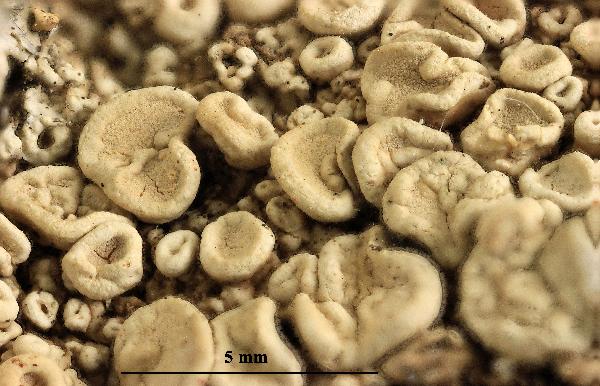

Felix Schumm - CC BY 4.0
[VZ1337], Jugoslavia. Macedonia, montes Galli ica, secus viam inter
Trpejca et Otisovo, 1550 m. Ad cortices Quercuum vetustarum. Leg. A.
V zda, 11.07.1975, EX A. V ZDA: LICHENES SELECTI EXSICCATI
NR.1337. As O. szatalaensis
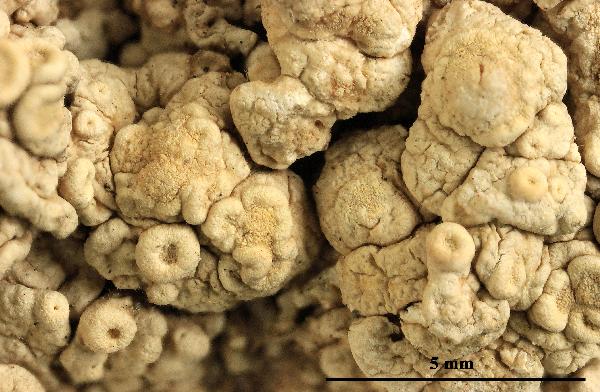

Felix Schumm - CC BY 4.0
[VZ1337], Jugoslavia. Macedonia, montes Galli ica, secus viam interTrpejca et Otisovo, 1550 m. Ad cortices Quercuum vetustarum. Leg. A.Vezda, 11.07.1975, EX A. VEZDA: LICHENES SELECTI EXSICCATI NR.1337. As O. szatalaensis
Growth form: Crustose
Substrata: bark
Photobiont: green algae other than Trentepohlia
Reproductive strategy: mainly sexual
Commonnes-rarity: (info)
Alpine belt: absent
Subalpine belt: extremely rare
Oromediterranean belt: absent
Montane belt: very rare
Submediterranean belt: absent
Padanian area: absent
Humid submediterranean belt: absent
Humid mediterranean belt: absent
Dry mediterranean belt: absent

Predictive model
| Herbarium samples |


P.L. Nimis; Owner: Department of Life Sciences, University of Trieste
Herbarium: TSB (10645)
2001/12/10
apothecium


P.L. Nimis; Owner: Department of Life Sciences, University of Trieste
Herbarium: TSB (35713)
2003/01/22
apothecium


P.L. Nimis; Owner: Department of Life Sciences, University of Trieste
Herbarium: TSB (10645)
2001/12/10


P.L. Nimis; Owner: Department of Life Sciences, University of Trieste
Herbarium: TSB (35713)
2003/01/22


Felix Schumm – CC BY-SA 4.0
Image from: F. Schumm (2008) - Flechten Madeiras, der Kanaren und Azoren. Beck, OHG - ISBN: 978-3-00-023700-3


Felix Schumm - CC BY 4.0
[9385], Spanien, Kanaren, La Gomera: Bei Arure an der Straße nach Las Hayas. Trockener Abhang mit Felsblöcken und Euphorbia. 28°07.895 N, 17°18.983 W, 870 m, an Rinde . Leg. F. Schumm, 14.02.2002, det. F. Schumm, 2007. - Hymenium 270 μm, Paraphysen stark verzweigt; Sporen meist verkümmert, breit ellipsoidisch, 50-60 x 27-33 μm. Thallus K-, C+ gelb, KC-, P-; Scheibe K-, C-, KC- bis etwas gelblich, P-. As O. szatalaensis


Felix Schumm - CC BY 4.0
[9385], Spanien, Kanaren, La Gomera: Bei Arure an der Straße nach Las Hayas. Trockener Abhang mit Felsblöcken und Euphorbia. 28°07.895 N, 17°18.983 W, 870 m, an Rinde . Leg. F. Schumm, 14.02.2002, det. F. Schumm, 2007. - Hymenium 270 μm, Paraphysen stark verzweigt; Sporen meist verkümmert, breit ellipsoidisch, 50-60 x 27-33 μm. Thallus K-, C+ gelb, KC-, P-; Scheibe K-, C-, KC- bis etwas gelblich, P-. As O. szatalaensis


Felix Schumm - CC BY 4.0
[9385], Spanien, Kanaren, La Gomera: Bei Arure an der Straße nach Las Hayas. Trockener Abhang mit Felsblöcken und Euphorbia. 28°07.895 N, 17°18.983 W, 870 m, an Rinde . Leg. F. Schumm, 14.02.2002, det. F. Schumm, 2007. - Hymenium 270 μm, Paraphysen stark verzweigt; Sporen meist verkümmert, breit ellipsoidisch, 50-60 x 27-33 μm. Thallus K-, C+ gelb, KC-, P-; Scheibe K-, C-, KC- bis etwas gelblich, P-. As O. szatalaensis


Felix Schumm - CC BY 4.0
[9385], Spanien, Kanaren, La Gomera: Bei Arure an der Straße nach Las Hayas. Trockener Abhang mit Felsblöcken und Euphorbia. 28°07.895 N, 17°18.983 W, 870 m, an Rinde . Leg. F. Schumm, 14.02.2002, det. F. Schumm, 2007. - Hymenium 270 μm, Paraphysen stark verzweigt; Sporen meist verkümmert, breit ellipsoidisch, 50-60 x 27-33 μm. Thallus K-, C+ gelb, KC-, P-; Scheibe K-, C-, KC- bis etwas gelblich, P-. As O. szatalaensis


Felix Schumm - CC BY 4.0
[9385], Spanien, Kanaren, La Gomera: Bei Arure an der Straße nach Las Hayas. Trockener Abhang mit Felsblöcken und Euphorbia. 28°07.895 N, 17°18.983 W, 870 m, an Rinde . Leg. F. Schumm, 14.02.2002, det. F. Schumm, 2007. - Hymenium 270 μm, Paraphysen stark verzweigt; Sporen meist verkümmert, breit ellipsoidisch, 50-60 x 27-33 μm. Thallus K-, C+ gelb, KC-, P-; Scheibe K-, C-, KC- bis etwas gelblich, P-. As O. szatalaensis


Felix Schumm - CC BY 4.0
[9385], Spanien, Kanaren, La Gomera: Bei Arure an der Straße nach Las Hayas. Trockener Abhang mit Felsblöcken und Euphorbia. 28°07.895 N, 17°18.983 W, 870 m, an Rinde . Leg. F. Schumm, 14.02.2002, det. F. Schumm, 2007. - Hymenium 270 μm, Paraphysen stark verzweigt; Sporen meist verkümmert, breit ellipsoidisch, 50-60 x 27-33 μm. Thallus K-, C+ gelb, KC-, P-; Scheibe K-, C-, KC- bis etwas gelblich, P-. As O. szatalaensis


Felix Schumm - CC BY 4.0
[9385], Spanien, Kanaren, La Gomera: Bei Arure an der Straße nach Las Hayas. Trockener Abhang mit Felsblöcken und Euphorbia. 28°07.895 N, 17°18.983 W, 870 m, an Rinde . Leg. F. Schumm, 14.02.2002, det. F. Schumm, 2007. - Hymenium 270 μm, Paraphysen stark verzweigt; Sporen meist verkümmert, breit ellipsoidisch, 50-60 x 27-33 μm. Thallus K-, C+ gelb, KC-, P-; Scheibe K-, C-, KC- bis etwas gelblich, P-. As O. szatalaensis


Felix Schumm - CC BY 4.0
[9385], Spanien, Kanaren, La Gomera: Bei Arure an der Straße nach Las Hayas. Trockener Abhang mit Felsblöcken und Euphorbia. 28°07.895 N, 17°18.983 W, 870 m, an Rinde . Leg. F. Schumm, 14.02.2002, det. F. Schumm, 2007. - Hymenium 270 μm, Paraphysen stark verzweigt; Sporen meist verkümmert, breit ellipsoidisch, 50-60 x 27-33 μm. Thallus K-, C+ gelb, KC-, P-; Scheibe K-, C-, KC- bis etwas gelblich, P-. As O. szatalaensis


Felix Schumm - CC BY 4.0
[9385], Spanien, Kanaren, La Gomera: Bei Arure an der Straße nach Las Hayas. Trockener Abhang mit Felsblöcken und Euphorbia. 28°07.895 N, 17°18.983 W, 870 m, an Rinde . Leg. F. Schumm, 14.02.2002, det. F. Schumm, 2007. - Hymenium 270 μm, Paraphysen stark verzweigt; Sporen meist verkümmert, breit ellipsoidisch, 50-60 x 27-33 μm. Thallus K-, C+ gelb, KC-, P-; Scheibe K-, C-, KC- bis etwas gelblich, P-. As O. szatalaensis


Felix Schumm - CC BY 4.0
[9385], Spanien, Kanaren, La Gomera: Bei Arure an der Straße nach Las Hayas. Trockener Abhang mit Felsblöcken und Euphorbia. 28°07.895 N, 17°18.983 W, 870 m, an Rinde . Leg. F. Schumm, 14.02.2002, det. F. Schumm, 2007. - Hymenium 270 μm, Paraphysen stark verzweigt; Sporen meist verkümmert, breit ellipsoidisch, 50-60 x 27-33 μm. Thallus K-, C+ gelb, KC-, P-; Scheibe K-, C-, KC- bis etwas gelblich, P-. As O. szatalaensis


Felix Schumm - CC BY 4.0
[VZ1337], Jugoslavia. Macedonia, montes Galli ica, secus viam inter Trpejca et Otisovo, 1550 m. Ad cortices Quercuum vetustarum. Leg. A. V zda, 11.07.1975, EX A. V ZDA: LICHENES SELECTI EXSICCATI NR.1337. As O. szatalaensis


 DOLICHENS
DOLICHENS

